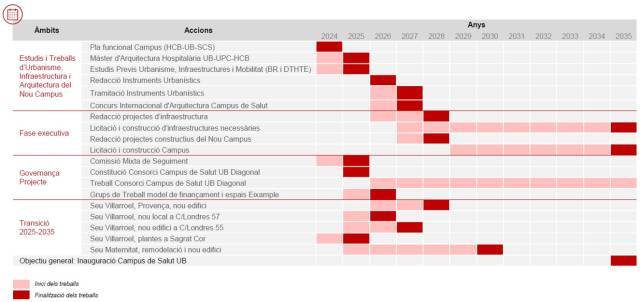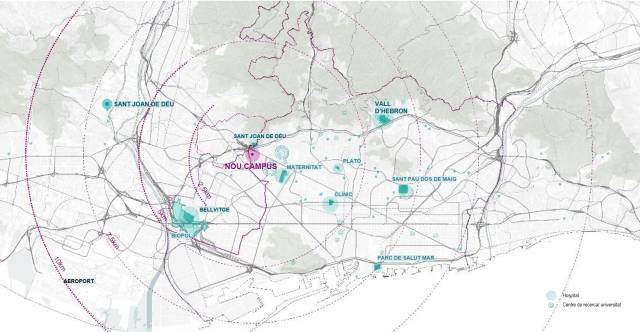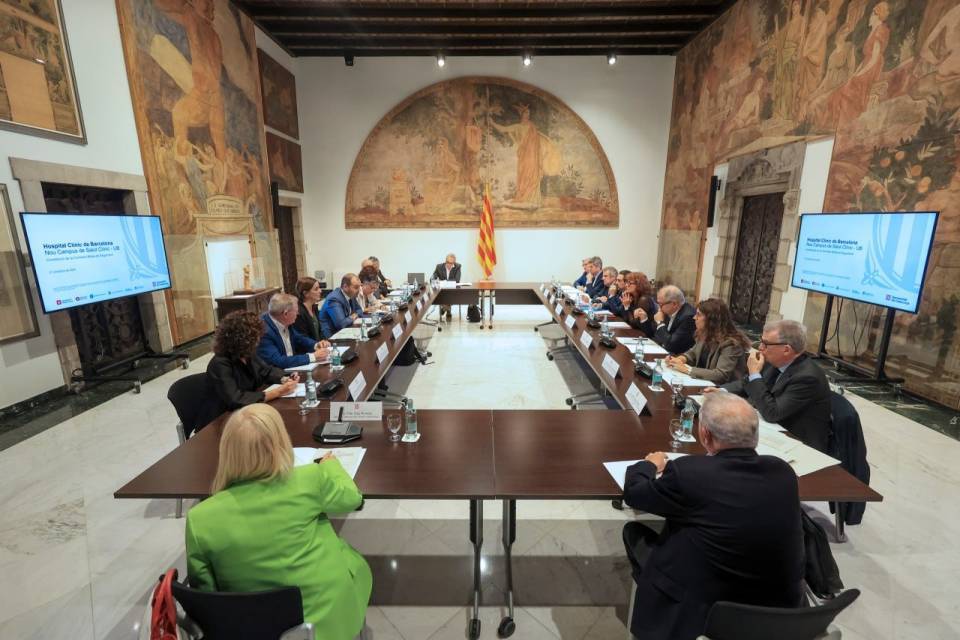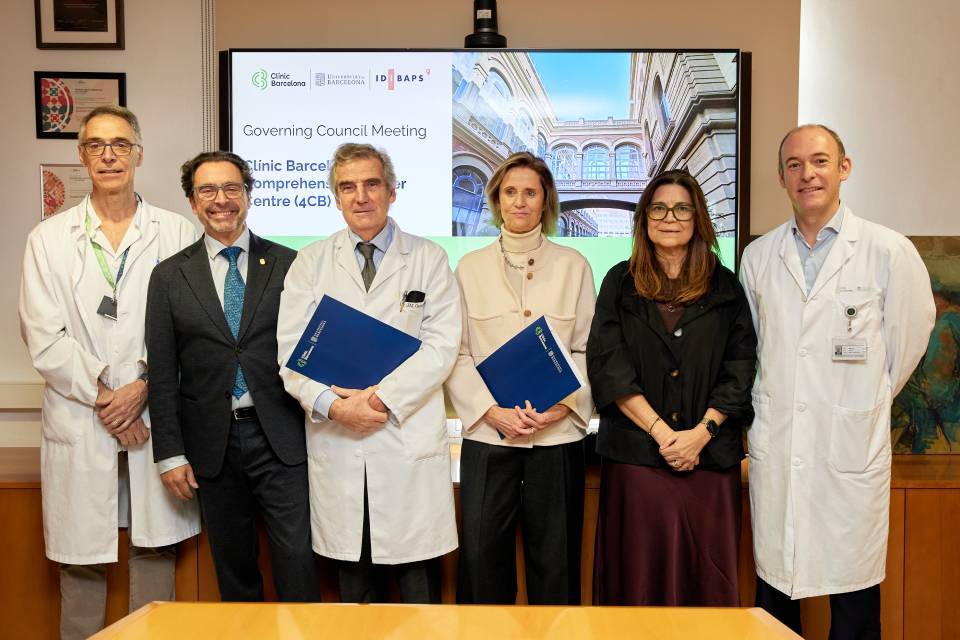Further progress has been made in the development of the future Hospital Clínic de Barcelona – University of Barcelona health campus at the Eix Salut Diagonal. This Monday, a meeting was held to set up the Joint Monitoring Committee for the project, which will act as a governing and coordinating body for the administrations involved. The Committee, therefore, has now been set in motion to start specifying all the key aspects for making the campus a reality including cooperation between the different actors, the planning and programming of each of the phases and the requirements in terms of uses, financing, the agreement regarding the transfer of the spaces at the current sports complex of the University of Barcelona (UB) at Avinguda Diagonal, 695-701, and the urban transformation and infrastructures that will have to be carried out.
The Minister of the Presidency, Albert Dalmau, stated that today “the machinery is being set in motion” to give a “definitive boost to the extension and relocation of the Hospital Clínic, one of the most important health hubs in the country as well as an important centre for research and teaching, which must position the country as a leading region in Europe in the field of healthcare”.
In view of the Hospital Clínic’s objective needs for growth, in recent years the various Catalan public administrations involved in its improvement process—the Generalitat, Barcelona City Council, the Hospital Clínic, the University of Barcelona, l’Hospitalet de Llobregat City Council, Esplugues de Llobregat City Council and Barcelona Provincial Council—have promoted several measures for working together towards the goal of pooling their resources and agreeing on the terms of the transformation.
Since 2021, collaboration between the administrations has made it possible to define the location and the research and academic activities that will make up a new health campus around the new hospital. The most recent agreement, signed by all the administrations on 29 January 2024, already provided the necessary governance tools for a project of the complexity and magnitude of the new campus, with 300,000 m2 of floor space and comprising various municipalities and institutions.
Now, the constitution of the Joint Monitoring Committee is a fundamental step towards providing the project with a coordination body with a very broad and transversal structure, with representation from all the institutions and departments that form part of it. The Committee, chaired by the Minister of the Presidency, Albert Dalmau, will take on one of the first tasks, which is to begin the work of creating the consortium that will manage the campus, an instrument already foreseen in the January agreement and expected to be established over the course of the coming year.
Furthermore, the Committee is now working to activate, coordinate and promote all the necessary preliminary studies, some of which are already underway, and to define the timetable of phases and actions that will be required. In this regard, two specific working groups will be set up to define two important issues: one focusing on the funding model and the other on the definition of the future uses of the current Clínic headquarters on Carrer de Villarroel.
Juan Echániz, coordinator of the Committee
In the session for the constitution of the Committee, the coordinator was appointed. He will be in charge of directing the work and of addressing the needs of the administrative and technical structure for the development of the new Clínic. The coordinator will be Juan Echániz, the current Commissioner for Strategic Projects at Barcelona Provincial Council, who has a long professional career dedicated to local public management and policies, spatial planning, urban and territorial planning, professional public management and the improvement of local government. An architect who studied at the Escola Tècnica Superior d’Arquitectura, he has held various posts in Barcelona Provincial Council, Barcelona City Council and l’Hospitalet de Llobregat City Council, and has promoted the creation of organisations such as the Fòrum de Gestió Pública (Public Management Forum) and Fundación Democracia y Gobierno Local (Democracy and Local Government Foundation). He has also participated as a speaker or professor in several seminars, congresses and conferences.
Work in progress and next steps
A great deal of progress has already been made in specifying the uses and services of the future hospital and in the preparation of preliminary studies for the transformation of the entire area affected by the new facility. On the one hand, the Hospital Clínic and the University of Barcelona are working on the proposal for a functional programme for the future hospital and the other components of the campus—research institutes, Faculty of Medicine, etc.—which will be available before the end of 2024 for evaluation and study.
At the same time, the Master’s Degree in Hospital Architecture promoted by the University of Barcelona and the Hospital Clínic in collaboration with the Polytechnic University of Catalonia, has already started. It will be developed during the academic year 2024-2025, as a single course and without continuity. The final result of the master's degree will be the drafting of different preliminary studies that will serve as the basis for the international architecture competition that is planned to be launched in 2026, coinciding with the year in which Barcelona will be the World Capital of Architecture. The aim of the competition is to attract the best proposals and ideas from architecture professionals all over the world, with a view to drawing up the architectural and town-planning implementation project for the different functional programmes on the future campus.
With regard to the urban and infrastructure development of the urban sector where the new Clínic will be located, for several months, the public agency Barcelona Regional has been drafting a criteria document for the transformation of the area. The document is expected to be delivered in the first half of 2025, and will contain elements linked to accessibility, the environment, urban planning and mobility. These criteria will guide the drafting of the urban planning instruments for the future development of the area, which will be drawn up and processed between next year and 2027. Subsequently, the construction projects for the new campus will be drawn up between 2027 and 2028, to be followed by the tendering and execution of the works.
In order to ensure the campus has good connectivity, accessibility and services, adaptations will have to be made to mobility and transport infrastructures and other infrastructures necessary for it to function properly. In this respect, the Joint Monitoring Committee will ensure that the Ministry of Territory, Housing and Ecological Transition promotes work to update the forecasts of the Territorial and Sectorial Planning of the extension of Line 3 of the Metro, which currently ends at Zona Universitària. The aim is to include a station in the area of the new campus on the future route of the extension of the line, which is also planned to connect with Esplugues de Llobregat. The plan is to draw up the infrastructure projects between 2026 and 2028 and to carry out the works after that.
Overall, the planned actions, including the development of the surrounding area and the construction of the hospital and the research and academic centres follow a timeline that envisions the inauguration and operational launch of the future campus by 2035. That same year, the new metro station near the new campus is also expected to be finished and fully functional. Until then, the Hospital Clínic will be carrying out a progressive and adaptive transformation of the current central headquarters on Carrer de Villarroel and the surrounding area and other buildings used by the Hospital Clínic Consortium in accordance with the definition of the future care programme for the whole complex and the needs of other municipal facilities. In addition, Barcelona City Council’s initiative to unblock the plot of land on Carrer de Provença will be implemented, with the corresponding gain of space for the hospital.

Towards a Clínic with a new metropolitan centrality
The ultimate goal of the initiative is to establish the new Hospital Clínic de Barcelona – University of Barcelona campus, reinforcing the Eix Salut Diagonal, in an area measuring around 9.6 hectares on Avinguda Diagonal itself. Due to its strategic location, it will give the area a new metropolitan and inter-municipal centrality. It will have very good connections and be well linked to other areas of health, research and biomedical innovation, as well as to major infrastructures such as Josep Tarradellas Barcelona-El Prat airport.
The facilities of the future Clínic will include a hospital with a 200,000-m2 built-up area –at present it has 151,000 m2 of healthcare space divided between different centres–; areas for teaching, with 40,000 m2 for the Faculty of Medicine and Health Sciences—at present there are 26,000 m2—, and 50,000 m2 for the research and innovation institutions associated with the hospital and the University of Barcelona—at present there are 30,000 m2.

The transformation will allow the Hospital Clínic to consolidate itself as the leading facility that it is today, with top-level clinical capacity and high technology, closely linked to university teaching and scientific research, which makes it one of the most important healthcare complexes in Spain and the rest of Europe. As well as the facilities of the new Hospital Clínic Barcelona, the Eix Salut Diagonal will house the new Faculty of Medicine and Health Sciences of the University of Barcelona and several leading research centres. Together with the Sant Joan de Déu Campus, the UB’s Barcelona Science Park and the Zona Universitària, the Campus Clínic is one of Catalonia’s most ambitious strategic projects for the next decade. This condition makes it a backbone of society from a point of view of excellence in the design of public services, and grants it a position of institutional reference that goes beyond the scope of healthcare.
Full composition of the Joint Monitoring Committee
The members of the Joint Monitoring Committee for the construction of the new Hospital Clínic Barcelona – UB health campus are:
Generalitat de Catalunya:
Ministry of the Presidency;
- Albert Dalmau Miranda, Minister of the Presidency.
- Eva Giménez Corrons, Secretary General of the Presidency.
- Mónica Lafuente de la Torre, Director General of Interdepartmental Coordination.
Ministry of Health
- Olga Pané Mena, Minister of Health.
- Ramon Canal Comaposada, Director of the Catalan Health Service.
Ministry of Research and Universities
- Núria Montserrat Pulido, Minister of Research and Universities.
Ministry of Economy and Finance
- Juli Fernández Iruela, Secretary General of the Economy and Finance.
Ministry of Territory, Housing and Ecological Transition
- Manel Nadal i Farreras, Secretary of Mobility and Infrastructures.
Barcelona City Council
- Laia Bonet Rull, Deputy Mayor for Urban Planning, Ecological Transition, Urban Services and Housing.
- Jordi Valls Riera, Deputy Mayor for Economy, Finance, Economic Promotion and Tourism.
- Marta Villanueva Cendán, Councillor for Health, People with Disabilities and Strategy against Loneliness.
L'Hospitalet de Llobregat City Council
- José Antonio Alcaide Martín, Councillor for Urban Agenda 2030/2050.
Esplugues de Llobregat City Council
- Eduard Sanz Garcia, Mayor.
Barcelona Provincial Council
- Juan Echániz Sans, Commissioner for Strategic Projects.
University of Barcelona
- Joan Guàrdia i Olmos, Rector of the UB
Hospital Clínic de Barcelona Consortium
- Josep Maria Campistol i Plana, Director General.




